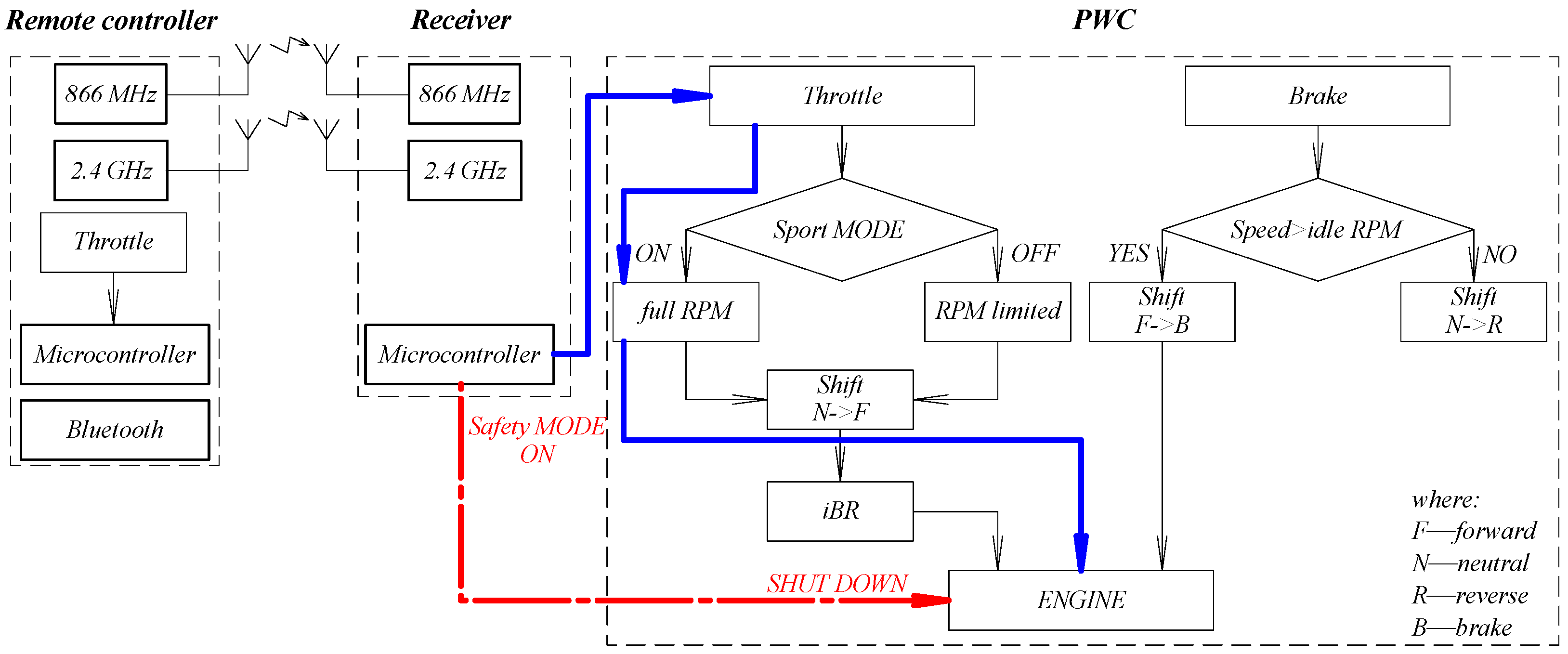Personal Watercraft Remote Control Communication Fault Detection †
Abstract
1. Introduction
2. Materials and Methods
3. Results
3.1. Remote Controller Machining Tolerance
3.2. Remote Housing Shading
3.3. Software Audit
4. Conclusions
Funding
Institutional Review Board Statement
Informed Consent Statement
Data Availability Statement
Conflicts of Interest
References
- Ishii, H.H. Control with limited communication and message losses. Syst. Control Lett. 2008, 57, 322–331. [Google Scholar] [CrossRef]
- Dudnikov, S.Y.; Vertegel, V.V.; Golovin, V.V.; Tyschuk, Y.N. Remote control system for the unmanned floating platform. In Proceedings of the IOP Conference Series: Materials Science and Engineering, Tel Aviv, Israel, 21–23 February 2021. [Google Scholar] [CrossRef]
- Guo, W.; Wang, S.; Dun, W. The Design of a Control System for an Unmanned Surface Vehicle. Open Autom. Control Syst. J. 2015, 7, 150–156. [Google Scholar] [CrossRef]
- Stateczny, A.; Burdziakowski, P. Universal Autonomous Control and Management System for Multipurpose Unmanned Surface Vessel. Pol. Marit. Res. 2019, 26, 30–39. [Google Scholar] [CrossRef]
- Mickhayluck, Y.P.; Iskiv, V.M.; Golovin, V.V.; Schekaturin, A.A.; Afonin, I.L.; Gimpilevich, Y.B. Study of the possibility of using the communication system with IEEE 802.22 for remote control of an unmanned vessel. In Proceedings of the 2017 IEEE International Conference on Microwaves, Antennas, Communications and Electronic Systems (COMCAS), Tel Aviv, Israel, 13–15 November 2017. [Google Scholar] [CrossRef]
- Tyschuk, Y.; Vertegel, V.; Nikiforov, S.; Nesterenko, A. Development and Implementation of a Remote-Control System for an Unmanned Research Small Vessel. Transp. Res. Proc. 2023, 68, 395–401. [Google Scholar] [CrossRef]
- Afonin, I.L.; Iskiv, V.M.; Mickhayluck, Y.P.; Redkina, E.A.; Tian, N.G.; Schekaturin, A.A. Principles of designing the digital radio electronics system for unmanned vessel remote control. In Proceedings of the 26th International Conference Microwave and Telecommunication Technologies (CriMiCo 2016), Sevastopol, Russia, 4–10 September 2016. [Google Scholar]
- Chang, X.; Li, Y.; Wang, Z. Accuracy-aware interference modeling and measurement in wireless sensor networks. IEEE Trans. Mob. Comput. 2016, 15, 278–291. [Google Scholar] [CrossRef]
- Prukner, P.; Kuczmann, M. Applications of periodic structures and metamaterials for antenna design. Acta Tech. Jaurinensis 2022, 15, 188–192. [Google Scholar] [CrossRef]
- Zuffanelli, S. Antenna Design Solutions for RFID Tags Based on Metamaterial-Inspired Resonators and Other Resonant Structures; Springer International Publishing AG: Cham, Switzerland, 2017. [Google Scholar]
- Balanis, C.A. Antenna Theory: Analysis and Design, 3rd ed.; Wiley: New York, NY, USA, 2016. [Google Scholar]
- Péter, T. Komplex célfüggvény és ekvivalencia osztályok alkalmazása gépjármű lengőrendszerek térbeli sztochasztikus modelljeinek optimálására. In Proceedings of the Magyarok Szerepe a Világ Természettudományos és Műszaki Haladásában III, Tudományos találkozó, Budapest, Hungary, 14–18 August 1992. [Google Scholar]





Disclaimer/Publisher’s Note: The statements, opinions and data contained in all publications are solely those of the individual author(s) and contributor(s) and not of MDPI and/or the editor(s). MDPI and/or the editor(s) disclaim responsibility for any injury to people or property resulting from any ideas, methods, instructions or products referred to in the content. |
© 2024 by the author. Licensee MDPI, Basel, Switzerland. This article is an open access article distributed under the terms and conditions of the Creative Commons Attribution (CC BY) license (https://creativecommons.org/licenses/by/4.0/).
Share and Cite
Titrik, Á. Personal Watercraft Remote Control Communication Fault Detection. Eng. Proc. 2024, 79, 8. https://doi.org/10.3390/engproc2024079008
Titrik Á. Personal Watercraft Remote Control Communication Fault Detection. Engineering Proceedings. 2024; 79(1):8. https://doi.org/10.3390/engproc2024079008
Chicago/Turabian StyleTitrik, Ádám. 2024. "Personal Watercraft Remote Control Communication Fault Detection" Engineering Proceedings 79, no. 1: 8. https://doi.org/10.3390/engproc2024079008
APA StyleTitrik, Á. (2024). Personal Watercraft Remote Control Communication Fault Detection. Engineering Proceedings, 79(1), 8. https://doi.org/10.3390/engproc2024079008




